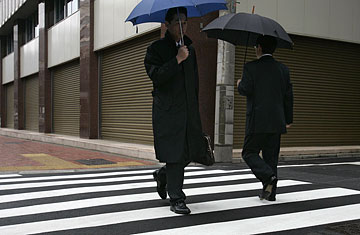
Men walk past a shuttered office building in a downtown business district of Tokyo on April 1, 2009
Before leaving for the G-20 Summit in London this week, Japan's Prime Minister Taro Aso said that his country is "still in a condition that you could call an economic crisis." Judging by the results of the Bank of Japan's quarterly tankan survey released April 1, it's clear that more than 10,000 Japanese businesses agree. The much-watched quarterly economic survey, which has measured business confidence across all sectors of the world's second-largest economy since 1974, reveals that sentiment among large manufacturers has reached a historic low and that small-and medium-sized companies think the economy will continue to worsen.
"The results are terribly bad," says Masaaki Kanno, chief economist at JPMorgan Securities in Tokyo. "But it was not a surprise, as other economic indicators had shown that this would be so." The farther the index's value from zero, the stronger the sentiment — either positive or negative — and the March survey reveals manufacturers' confidence bottomed out at minus 58, down from minus 24 in December. "The simple message of the tankan survey is that businesses remain cautious and their focus is toward June this year," says Kanno. "It suggests that the economy is going through one of the worst recessions in history in the next three months." (Read "Sony's Woes: Japan's Iconic Brands Under Fire.")
Few would argue otherwise. Japan's unemployment rate rose to 4.4% in February, the highest since January 2006, and household spending dropped 3.5%, declining for the 12th straight month. Judging by the tankan, there is evidence that aftershocks from the huge hits Japan's large manufacturers and exporters have taken over the last six months are rippling though the economy. Consider the difference in the outlooks of large and small businesses. Across the board, forecasts for the second half of fiscal year 2008 indicate companies expect to lose money. Sentiment among manufacturers is at minus 60, an unprecedented low. But among larger firms, there is a modicum of optimism. They expect confidence to rise in June from minus 58 to minus 51.
Among small businesses, however, the horizon continues to darken. One reason for the difference in outlook, says Kanno, is that large companies, which faced massive declines in exports, have started to adapt to the harsh conditions, particularly by lowering production. A report released this week from the Ministry of Economy, Trade and Industry showed that industrial output for February fell 9.4%, after a record 10.2% decline in January. "We're likely to go along with the low level of the bottom for the next couple of months, and improvement will be fragile and vulnerable to any kind of shock," says Kanno. "That's why the government needs a further stimulus package and the BOJ (Bank of Japan) needs an easing policy to make sure the economy moves toward recovery."
Prior to heading for the G-20 summit, Aso underscored the need for stronger government measures, saying more stimulus spending was necessary to "prevent the economy from falling through the floor." Three packages worth a total of roughly $750 billion have already been passed in the last six months. Last week, the Diet approved the budget for the fiscal year beginning April 1, paving the way for yet another stimulus plan.
Details have yet to be worked out. But at a March 31 news conference, Aso highlighted three overarching objectives of the stimulus package: spending to "prevent business activity from slumping further," to protect jobs, and initiation of programs that "lead to a reinforcement of Japan's future growth potential." That long-term growth plan includes development of green technologies, including solar power and eco-friendly autos, and boosting exports of Japanese anime, music and other pop culture content. While Aso did not provide specifics on the size of the package, members within Aso's Liberal Democratic Party are calling for minimum spending to exceed $100 billion, dwarfing previous spending packages.
Aso, who recently affirmed a previous commitment by Japan to provide a $100 billion loan to the International Monetary Fund, is expected at the G-20 summit to lend support to a call by the U.S. for governments to spend more in a coordinated international effort to battle the recession. Aso's insistence that a stronger fiscal response is needed is in stark contrast to more cautious views on massive public spending programs shared by other leaders, including German chancellor Angela Merkel.
This week, Kaoru Yosano, Japan's economy and finance minister, said the country's stimulus measures will "far exceed" 2% of its gross domestic product, a level of spending recommended by the International Monetary Fund to ease the global recession. But this is contributing to Japan's already daunting government debt load, which Tokyo estimates to be nearly 160% of GDP.
See pictures of Japan and the world.
